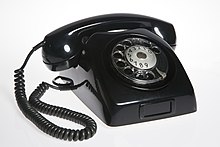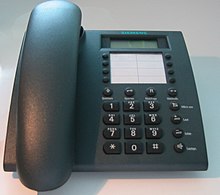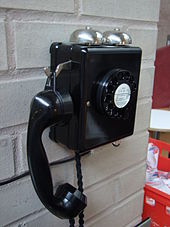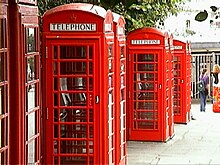phone
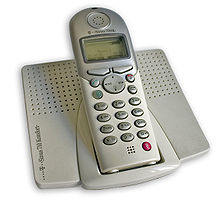




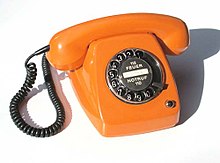



A telephone , formerly also telephone (from ancient Greek τῆλε tēle "fern" and φωνή phōnē "loud, tone, voice, language"; term coined by Philipp Reis ), also called telephone apparatus (FeAp) or telephone ( railway-internal abbreviation Fspr ), is a Communication means for the transmission of sounds and especially speech by means of electrical signals . The terms telephone and telephone set go back to the work of the general post director and linguist Heinrich von Stephan . The retronym landline phone is often used today to distinguish it from the mobile phone .
Colloquially , the term “telephone” is often used to describe the entire telephone system as well as the terminal of the telephone network . In Switzerland , “telephone” often also means a telephone conversation (telephone call): “Give me a phone” then means “Call me”.
The telephone system contains three main components:
- The apparatus for converting sound into electrical signals and back, as well as components for controlling the connection , the actual telephone set (also terminal)
- The telephone switching system ( local exchange )
- The transmission channel - originally a twin wire fed with direct current , today also time slots or radio channels
Telephone set - technology
In telephones , the sound is converted into electrical signals by a microphone and output as a sound wave at the receiver .
The sound conversion on the transmitter side takes place using various physical effects. In the case of a carbon microphone, for example, the effect of sound waves changes the electrical resistance of loosely piled carbon grains. A piezo microphone generates the voltage through the piezo effect . Microphones based on the electrostatic principle ( electret microphone ) are used by manufacturers such as Ericsson . Sometimes a membrane-coil arrangement uses electromagnetic induction to generate the signal voltage. Often the signals are immediately amplified by electronics integrated in the microphone capsule.
Components based on the membrane-coil principle (electromagnetic transducer) are used on the receiving side. Piezoelectric ear capsules are also used. Which converters are used depends on the year of construction and the price range of the device. The frequency range of the transmitted sound does not correspond to the entire range that can be heard by humans; for reasons of the economy of signal transmission, it is often limited from 300 to 3400 Hertz . Syllable intelligibility is sufficient if the upper transmission frequency is a few kilohertz and the lower a few hundred hertz. In the early days of telecommunications technology, extensive investigations were carried out on this.
Other components control the connection flow. These are hook switches , number switches or keypad for automatic or semi-automatic connection establishment, the crank inductor for manual connection establishment (often in OB operation ), inquiry button and, especially in the area of telephone systems, numerous other operating elements. Important terms in the expansion of the increasingly dense telephone network are switching technology and self-dialing remote service .
After all, a telephone has a bell. This used to work electromagnetically , decoupled from the telephone network direct voltage by a capacitor, directly on the ringing alternating voltage of 25 Hz (Germany) that was provided for signaling and superimposed on the direct voltage . Today, this ringing voltage, which is still used today for analog telephone connections, is mostly evaluated electronically.
Transmission medium and technology used
Cable phones, the cable network
The simultaneous signal transmission in both directions in two cores is realized with a differential transformer (see hybrid connection ). This prevents you from hearing yourself excessively in the telephone receiver . This is also called back loss .
Telephones also contain a generator for generating the dialing pulses ( rotary dial or electronic) or the modulated tones of the multi-frequency dialing process (DTMF). The hearing and speaking capsules contain simple microphones or speakers, similar to those in headphones .
A direct voltage (around 60 V) is sent from the exchange from the subscriber line to the telephone via resistors . When on-hook , there is no noticeable current in the phone - it is high-resistance . If the telephone receiver is picked up, this voltage breaks down to a defined value (approx. 12 V), as the telephone is now connected to the line with a resistance of approx. 600 ohms. This voltage serves as the supply voltage (previously it was only used to supply the carbon microphone) and at the same time signals the status as well as the dialing pulses in the (outdated) pulse dialing process (these interrupt the circuit periodically). Before the other party accepts the call, a tone signal is sent to the calling telephone (dial tone or busy tone, see audible tones ), at the same time an alternating voltage of low frequency (25 Hz in Germany) superimposed on the direct voltage is sent from the exchange to the ringing telephone ( ringing voltage ). In the past, this alternating voltage directly excited an electromagnetic ring, today it is electronically detected by the telephone and can also control electronically generated ring tones.
To date, telephones have been connected to local exchanges primarily via the telephone company’s cable networks . In the beginning, two wires ran from each telephone to telegraph poles to a central point, where they were locked on light bulbs or flap cabinets. With this principle, there was soon the unmistakable tangle of cables and telegraph poles on the streets, known from historical photos, 50 cables on double and triple rods were not unusual.
Because of the high susceptibility to failure, Germany began in the spring of 1876 to lay the entire long-distance telegraph network underground as a cable network. The project was provisionally completed in 1881, 30 million marks had been built. The beginning of the European cable network in long-distance telephone traffic was made in 1913/14 with the laying of the so-called Rhineland cable from Berlin to Hanover, which was initially discontinued due to the outbreak of the First World War .
Wireless radio channels are increasingly being used for telephony , primarily due to car telephones and cell phones .
Classic telephones have been increasingly being replaced by IP telephony since the 2010s .
Satellite phone
A system with satellite telephones has been available since 1982 , with which telephone calls can be made worldwide without a comprehensive terrestrial infrastructure .
Cordless phones, DECT
Digital Enhanced Cordless Telecommunications (DECT, digital, improved cordless telecommunications; until 1995 Digital European Cordless Telephony) is the current standard for cordless telephones . The cable network is used again from a base station to set up a call. Radio operation only takes place between the base station and the handset.
"Cordless telephone" corresponds to the English term cordless telephone , abbreviated to CT. Under this name, two standardized techniques were initially brought onto the market from 1984, CT1 and CT2. CT1 is defined by a cordless telephone with 80 analog duplex channels and an organization channel. CT2 had 40 duplex channels and worked with a digital transmission method. CT1 telephones are no longer permitted in Germany; this has also been the case for CT1 + and CT2 telephones since 2009, and interference from other radio services has been possible since January 1, 2003. The use of a telephone with CT1 + or CT2 standard from January 2009 constitutes a violation of the Telecommunications Act. The owner of the telephone can be determined by measurements and a fine can be imposed which, according to the Federal Network Agency , can amount to more than 1000 euros. According to a statement by the federal government from 2008, however, operation is tolerated as long as there is no interference from the device.
Mobile telephony
The mobile phone , coll. "Mobile phone", is a portable telephone that communicates with the telephone network via radio and can therefore be used anywhere.
HD telephony
HD telephony is a sound transmission that has an even higher quality. The basic requirement for this is that both telephone connections are capable of this.
Telephone contract
In order to be able to operate remote communication by means of a telephone, it must be activated in a telephone network . The resulting costs are billed to the telephone customer by the telephone company . The basis for the payment is the concluded telephone contract . This is a mixture of service , work and, if applicable, sales contract . Since telecommunications are subject to the regulation of the Federal Network Agency , the civil law freedom of contract is restricted by public law and the resulting regulatory measures.
History of the phone
Before voice transmission using electrical signals became established, there were more or less successful attempts at non-electrical telephony. Around 1670, Samuel Morland made attempts in London to transmit speech with instruments that resembled a trumpet. The idea was picked up again about 100 years later by Johann Heinrich Lambert . In 1783 a prospectus appeared anonymously in Paris under the title About the propagation of sound and the voice in tubes [...] . This was intended to raise funds for a large-scale experiment. The project did not come to fruition with an estimated station distance of four kilometers and the associated high susceptibility to failure. In the 19th century, speaking pipelines were used for a long time in steam shipping e.g. B. used for the connection of the navigating bridge with the engine room.
The history of the telephone begins in 1837 when the American Samuel FB Morse constructed the Morse telegraph. This means that the precondition for the transmission of signals through electrical lines, which is important for the telephone, has already been put into practice. In 1854, the Parisian telegraph clerk Charles Bourseul (1829–1912) presented a lecture on possible techniques of electrical voice transmission. This was followed by practical developments of basically functioning telephone sets by Innocenzo Manzetti , Antonio Meucci , Tivadar Puskás , Philipp Reis , Elisha Gray and Alexander Graham Bell, among others . Of these early inventors, however, only Bell had the organizational skills to go beyond the laboratory test equipment and bring the telephone to market maturity as a complete system. For example, in Boston in 1876, Bell first put the telephone into practical use.
Bell's device consisted of a transducer that was used alternately as a microphone and as a remote receiver. It had a flexible metal membrane, a bar magnet and a wire coil surrounding the magnet. The sound waves of different strengths generated during discussion set the membrane vibrating. The changed magnetic flux induced electrical voltages in the coil. The sound waves, converted in this way into electrical signals, were passed on to the receiving telephone via a wire connection. The reverse process now took place in its converter. The incoming modulated current generated a variable magnetic field that set the membrane vibrating, creating sound waves again.
With devices of this type, successful attempts at transmission over an initially 6 km, then 26 km and finally 61 km were carried out in Berlin under the direction of Postmaster General Heinrich von Stephan and General Telegraph Director Budde. After these first attempts, Stephan had other Bell telephones made by Siemens & Halske . These events marked the beginning of operational telephony in Germany.
With the invention of the carbon microphone in 1878 by David Edward Hughes in connection with the improvement of the handset by Werner von Siemens , a much louder transmission and thus conversations over longer distances became possible (demonstration at the International Electrical Exhibition in 1883. ) the so-called manual mediation by the " Miss from Office " was used.
In order to give the user the possibility to set up his own connection ( self-dialing service ) , Almon Strowger began in 1888 with the development of an automatic telephone switching system. On March 10, 1891, Strowger, who was actually an undertaker by profession, patented this switching system (Automatic Telephone Exchange) under US Patent No. 447.918. According to tradition, Strowger was encouraged to develop an automatic switching system because a competing funeral home and the local "Miss from Office" took away incoming customer orders. With this system, a key was installed in the phone for the units, tens and hundreds of the call number to be dialed, which had to be pressed often according to the number. The operation was correspondingly cumbersome and error-prone and the installation effort was high, since each button was connected to the exchange via its own line.
Other self-dialing facilities for the telephone followed, such as that published on January 11, 1898 by AE Keith and brothers John and Charles J. Erickson, employees of the Strowger Automatic Telephone Exchange Company, under US patent no. 597,062 patented Strowger finger-wheel sub station dial . With this device, the number of wires for transmitting the dialing information has been reduced to two.
On April 29, 1913, the Siemens & Halske company patented the number switch that had been in use for a long time in telephones and which worked according to the pulse dialing method . The use of number switches in telephones is documented in Germany for 1908 and in the USA from at least 1907.
In 1955, the Bell Telephone Laboratories developed the multi-frequency dialing process (MFV). This type of dialing via buttons is the most common today for analog telephones.
With modern electronics and computer technology , the electromechanical elements could be replaced by semiconductor components, which made it possible to significantly reduce the size of the device and to equip it with more and more additional functions and to simplify operation as well as offer other possible uses - for example acoustic room monitoring.
For example, while calls were initially signaled by an electromechanical alarm clock, this has now been replaced by an electronic, usually adjustable, signal tone . Additional features include calling line identification for outgoing and incoming calls, number storage ( phone book , speed dialing or direct dialing), call forwarding, conference calls , call lists and hands-free calling. In addition, the telephone itself is now occasionally combined as a device unit with other end devices such as answering machines (mostly with remote access) and fax machines .
In addition to its primary function for voice communication, the telephone, together with the transmission and switching technology required for it, is an essential part of a global communications network that can be used to transmit all kinds of information in addition to voice.
The development of the mobile phone began in 1926 with a telephone service in trains of the Deutsche Reichsbahn and Reichspost on the route between Hamburg and Berlin. Mobile phones have been used across the board since the turn of the millennium.
The most important and best-known telephones in the history of German telecommunications technology were the W28 (from 1928), W38 and W48 (from 1938 and 1948), and the FeTAp 611 (from 1963).
In 1964, the first touch phone developed in Germany was presented: the Siemens Etafon . It had ten number keys that were staggered in two rows (1 3 5 7 9/2 4 6 8 0), four keys (now called direct dialing keys ) on which telephone numbers could be saved, and a hands-free system. The device was designed as a feasibility study because the components were too expensive for series production.
The FeTAp 751 was available from November 1976 as the first landline pushbutton telephone available in the Federal Republic of Germany. The cordless telephones that had been used for many years hit the German market at the end of the 1980s. The Stabo ST930, which was approved by the Deutsche Bundespost in 1988, is the first model in Germany .
In Switzerland, after the model 29 (1929), the widespread model 50 (1950, over two million copies) was introduced as a black wall and table model, the latter later also in gray. Model 70 (1970) has a slightly more modern look and was initially only available in gray, later in other colors for an additional charge and, from the 1980s, also with buttons (but still with pulse dialing). Only PTT-tested devices were allowed that could only be rented (or had to be rented) from the telecommunications office. The models of replicas from the early days of telephony and two models with names of American cities, which were around five to ten times more expensive to rent, but all had the same pulse technology and rotary dial, were virtually unattainable luxury shown in the front of the telephone book.
Special forms
Special telephones have been developed for special areas of application: built- in telephones , field telephones , pit telephones ( fire-proof ), house emergency call systems, emergency telephones . The most widespread special form worldwide, however, is the telephone booth or, more precisely, the telephone booth , with a fixed coin-operated telephone .
Fire alarm points
- See main article on fire alarms
Originally, fire alarm points were a special form of the call column that could connect a person seeking help with the fire brigade's operations center .
Emergency telephone
Emergency telephones are telecommunication devices that can be used free of charge and that make it possible to call for help in remote or particularly endangered areas. As a rule, only a specific call partner can be reached by pressing a call lever or call button (road maintenance service, emergency call center, etc.).
- See main article on emergency telephone
- Rescue Service Foundation Björn Steiger e. V. , the rescue chain after accidents
Home emergency call systems
Under emergency call (also wireless pendant, Rufhilfe, senior alarm) refers to a system based on telephone technology emergency system that makes it easier for living alone old or disabled people to call for help in an emergency, without having to use dial or keyboard. This enables those affected to live longer in their home and still have the security of not having to rely on rapid help e.g. B. having to do without relatives, doctors or emergency services. The alarm is usually triggered by a portable emergency call transmitter (small radio with one button), but it can also be a sensor that reacts to a fall. According to the Bundesverband Hausnotruf , there were providers of such systems in around 350 German cities in 2006, which can also be connected to one of the 180 call centers . Basic information and previously agreed procedural instructions for the various situations are stored there (e.g. if ... then inform person Xyz, ... alert the emergency services). In this way, around 350,000 people living in their private households were provided for in Germany.
art
The telephone is an extremely popular subject in art , music , literature or in film . Here is a small list of works in which the telephone plays a kind of leading role:
- Music / opera
- Telephone. Polka -Française op.165 by Eduard Strauss (1878)
- The telephone or love for three , opera by Gian Carlo Menotti (1947)
- Telephone book polka by Georg Kreisler (1957)
- La voix humaine , opera by Francis Poulenc (music) and Jean Cocteau (text) (1959)
- Telephone Line composed by Jeff Lynne , played with the Electric Light Orchestra (ELO) and released on the album A New World Record in 1976.
- Feature films
- When Calling Mord (1954) ("Dial M for Murder") by Alfred Hitchcock
- Voice on the Telephone (1965), feature film about a telephone chaplain who is called by a woman who has taken sleeping pills
- Telephone (1977), a feature film with Charles Bronson
- ET - The Extra-Terrestrial (1983), wants to call home
- Not Hang Up (2002), mainly set in a phone booth
- Works of art
- Salvador Dali Lobster Telephone , 1936
- Soft Pay-Telephone from Claes Oldenburg , 1963
Others
- Presumably the English captain John Taylor first claimed the term telephone in 1844 for his invention to transmit information by means of four trumpet-like tones over a large device with a sound-bundling funnel with a range of up to 15 kilometers.
- According to tradition, one of the first sentences transmitted by telephone was: "The horse does not eat cucumber salad" . ( see Philipp Reis )
- The prompt “ Be brief! “Was attached to public telephones until the 1970s.
- After ISDN in the 1990s, another technical upheaval began with IP telephony in the 2000s.
- Computer Telephony Integration (CTI) links computers and telecommunications.
- A telephone conversation can be viewed from a technical and social point of view.
- The telephone alphabet and radio alphabet can be found in the telephone book .
- AVON is the abbreviation for Official Directory of Area Codes , commonly known as a telephone code list .
- The international telephone code must be taken into account when making international calls .
- On telephone keypads , the digits 1 through 9 are arranged from top to bottom, unlike most calculators and computers.
- Video telephones and writing telephones with different technologies have mostly only established themselves for the deaf.
- A computer connection via the normal telephone network used to be made with an acoustic coupler , today with a modem .
- The telephone socket for analog connections is the telecommunications connection unit (TAE) in Germany, the TDO (geometrically incompatible with the TAE) in Austria , and elsewhere mostly the Western plug .
- The use of SMS short messages, which was initially widespread on mobile phones, is also possible as landline SMS with landline phones.
- With analog telephones, only two wires are required to transmit a call.
- The consultation key (R key) was used for special functions in telephone systems, such as taking calls from the exchange to transferring exchange calls. Today it has been replaced by the flash key .
- The homemade corded telephone is an old children's toy .
- The telephone network is operated by telecommunications companies.
- Makatel (abbreviation for magnetic card phone ) describes a method for cashless payment by credit card.
- The theatrophon is a system for stereophonic transmission of opera and theater performances over the telephone.
- The formerly official expression " Fernsprecher" was replaced by the designation telephone at the Federal Post Office in 1980 .
Primaries
See also
- List of all Wikipedia articles whose title starts with Telephone
- List of all Wikipedia articles whose title includes Telephone
- Red phone
literature
- Dietrich Arbenz: From drum selector to Optiset E - The history of wired telephones for Siemens private branch exchanges (1950–2000) . Herbert Utz Verlag, Munich 2009, ISBN 978-3-8316-0908-6 .
- Margret Baumann and Helmut Gold (eds.): Mensch Telefon. Aspects of telephone communication. Umschau / Braus, Heidelberg 2000 (= catalogs of the Museum Foundation Post and Telecommunications, 8).
- Jörg Becker (Ed.): Telecommunication: international telecommunications history, sociology and politics. Vistas, Berlin 1994.
- John Collard: Theoretical study of articulation and intelligibility in telephone circuits. Vienna 1928/29.
- Harvey Fletcher and JC Steinberg: Articulation testing methods. 1929.
- Christel Jörges (Ed.): Telephones 1863–2000: from the collections of the Museums for Communication. Edition Braus, Heidelberg 2001 (= catalogs of the Museum Foundation Post and Telecommunications, 9).
- Stefan Münker and Alexander Roesler (eds.): Telephone book: Contributions to a cultural history of the telephone. Suhrkamp, Frankfurt am Main 2000 (= Edition Suhrkamp, Volume 2174), ISBN 978-3-518-12174-0 .
- Avital Ronell : The phone book. Brinkmann and Bose, Berlin 2001.
- Rainer Schönhammer: Telephone design. The body of the telephone. Kerken, 2004. Free of charge online at uni-saarland.de .
- Gert Kaszynski and Jürgen Schönhoff: Telephone devices . Verlag Technik, Berlin 1991. With a very extensive bibliography.
- Clemens Schwender: How do I use the telephone? The instructions for making calls in the Berlin telephone directory 1881–1996 / 97. Berlin, Bern, New York 1997.
- François Smesny (Ed.): Telefoneschichten O-Ton-Produktion, Berlin 2010, ISBN 978-3-9810256-9-9 .
- Frank Thomas: Telephoning in Germany: organizational, technical and spatial development of a large-scale technical system. Campus-Verlag, Frankfurt am Main 1995.
Web links
- Museum for Communication - Bern
- Extensive private collection
- Collectors page with many pictures of old telephones (with circuit diagrams and repair instructions for W48 and similar telephones)
- History of telecommunications from 1833 to 1999 with pictures
- Regine Buschauer: Telephone. In: Historical Lexicon of Switzerland .
- Industrial wall telephones
- Guideline “Accessible hearing and communication in the world of work”: Checklist for accessible telephones The Hörkomm.de project supports the inclusion of hard-of-hearing employees.
- The Post's telephone program from 1985
- Museum Foundation Post and Telecommunications - Berlin, Frankfurt, Hamburg and Nuremberg
- Silvanus P. Thompson - Philipp Reis: Inventor of the Telephone A Biographical Sketch , London, 1883
Individual evidence
- ↑ Operating instructions T-Sinus 710 comfort. Status: 11.2001. (PDF; 4.76 MB) (No longer available online.) Deutsche Telekom, November 2001, archived from the original on January 31, 2015 ; Retrieved November 16, 2013 .
- ↑ Operating instructions for Easy CA 32 plus 1. (PDF; 1.1 MB) (No longer available online.) VTech Telecommunications Ltd. (Hong Kong) October 12, 2009; archived from the original on August 5, 2013 ; Retrieved November 16, 2013 .
- ^ The telephone, a telegraphic noise signal . In: Illustrirte Zeitung . No. 136 . Johann Jacob Weber, Leipzig 1846, p. 91-92 .
- ^ Wilhelm Gemoll : Greek-German school and hand dictionary . G. Freytag Verlag / Hölder-Pichler-Tempsky, Munich / Vienna 1965.
- ^ News from the districts. Electrical exhibition in Vienna. In: Badener Bezirks-Blatt , March 3, 1883, p. 5 (online at ANNO ).
- ↑ US patent No. 597,062
- ↑ button phone `Etafon` from Siemens. In: Getty Images . Accessed April 24, 2019 (illustration of the Etafon ).
- ↑ alpha-retro: 1964 - telephone "The technical report". In: alpha-retro (series on ARD-alpha ). Retrieved on April 24, 2019 (film by Egloff Schwaiger; the information cited is only contained in the film itself, not in the table of contents).
- ↑ Anniversary: 35 years ago the first pushbutton telephone came onto the market. teltarif.de Onlineverlag, November 15, 2011, accessed on November 16, 2013 .
- ↑ New: The Stabo ST930 , accessed on November 6, 2015
- ^ Phonebook polka
- ^ Hummer telephone of the Museum Foundation Post and Telecommunications
- ↑ Oldenburg's Soft Sculpture at guggenheim.org
- ^ The Telephone . In: The Year-Book of Facts in Science and Art . tape [1844] . David Bogue, London 1845, p. 55 ( online ).
